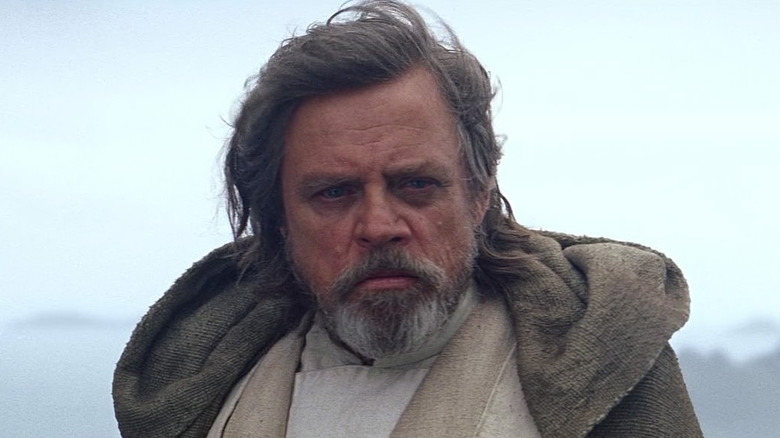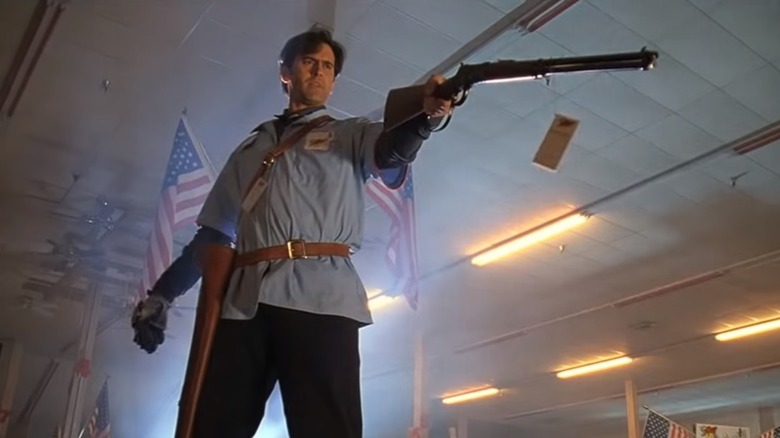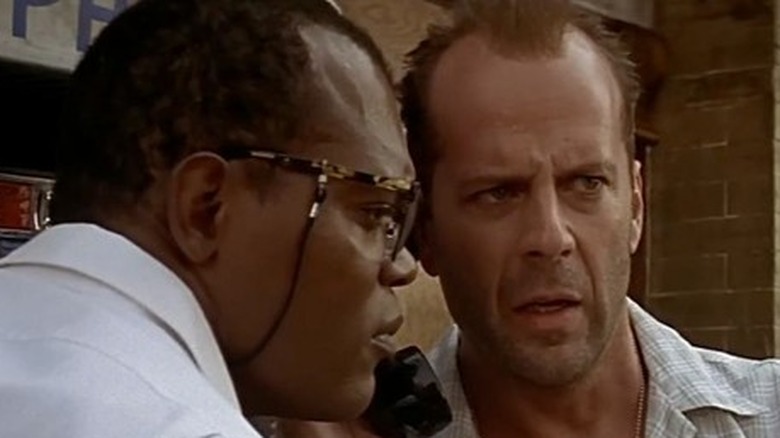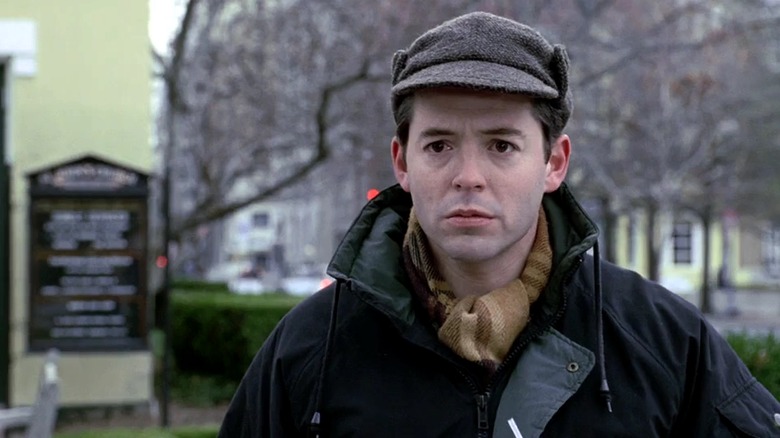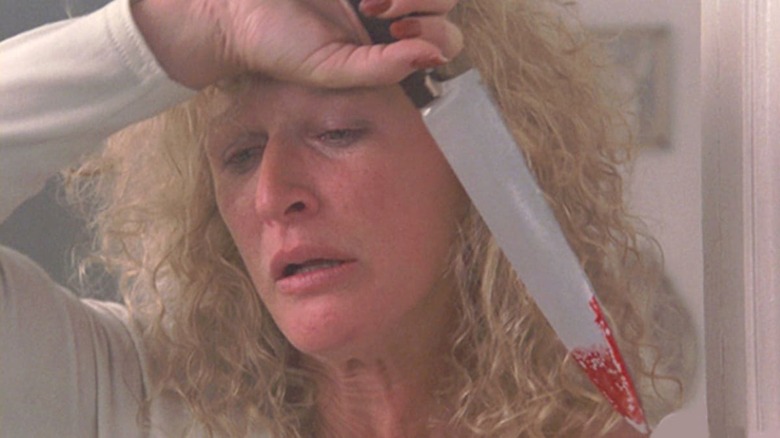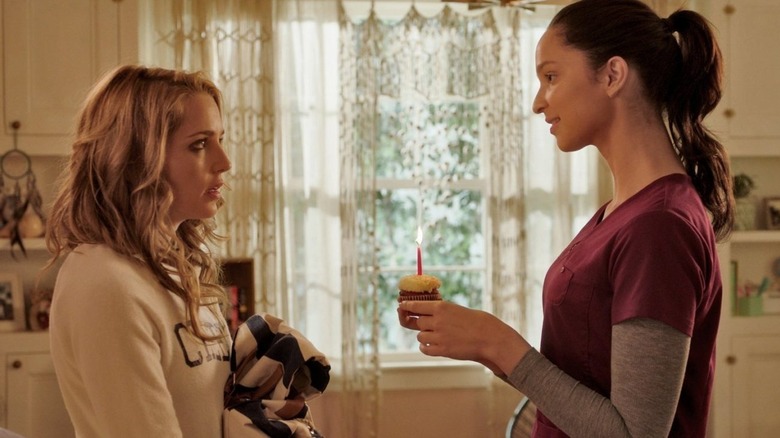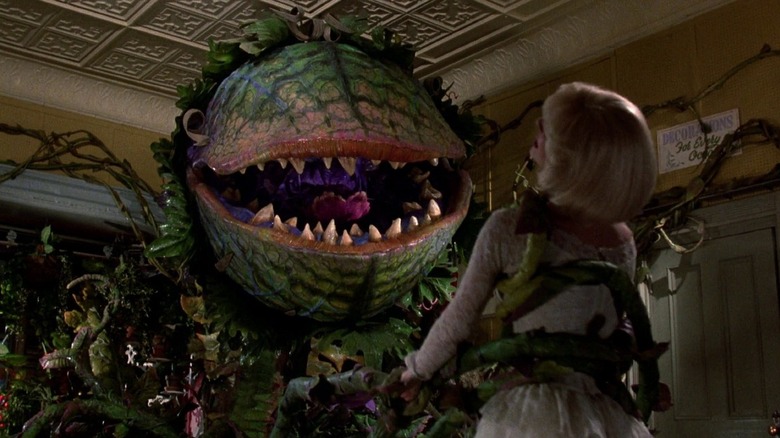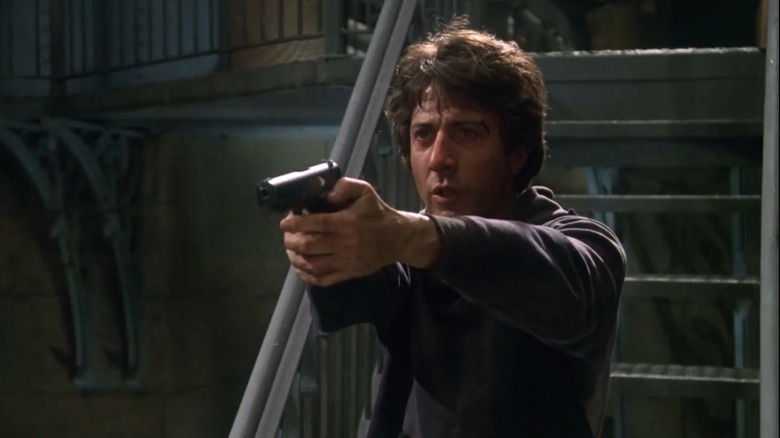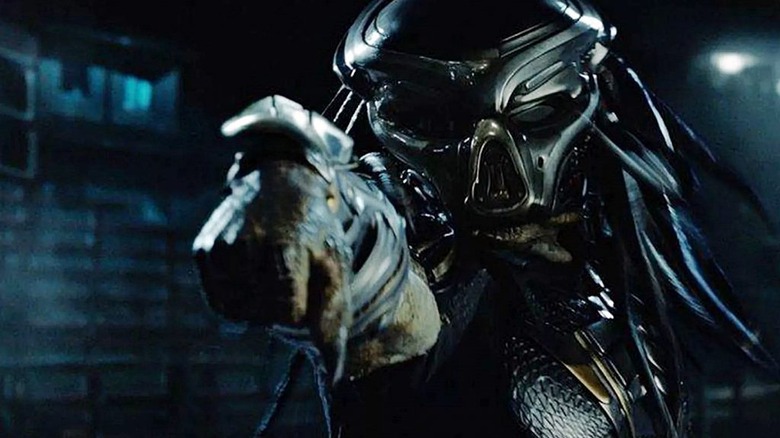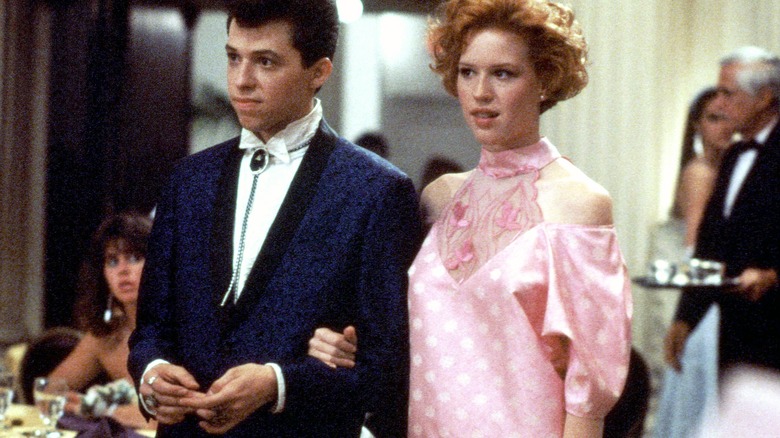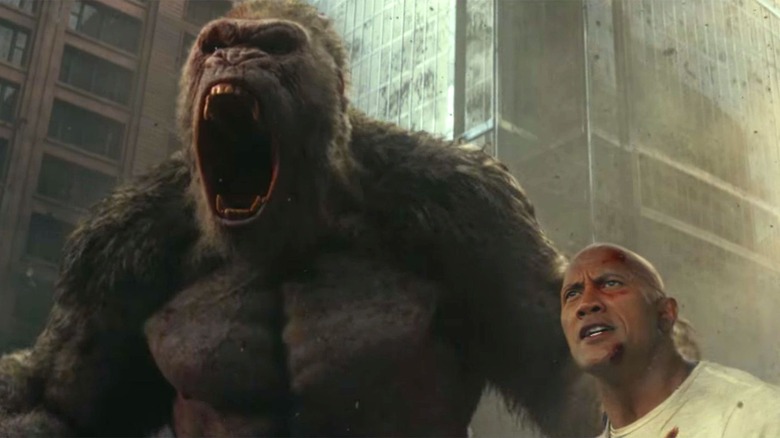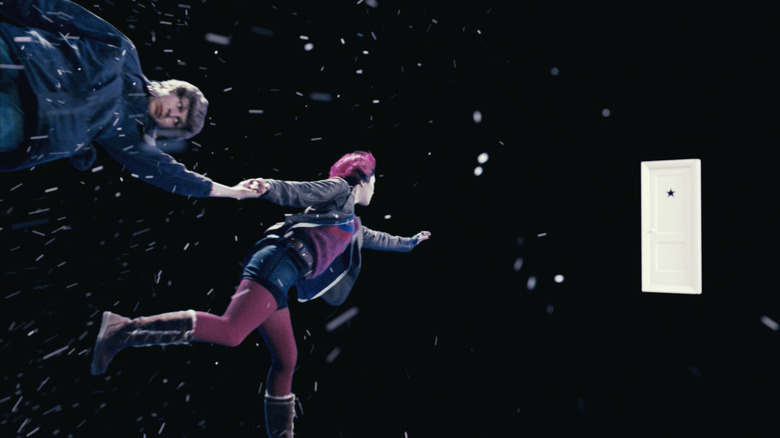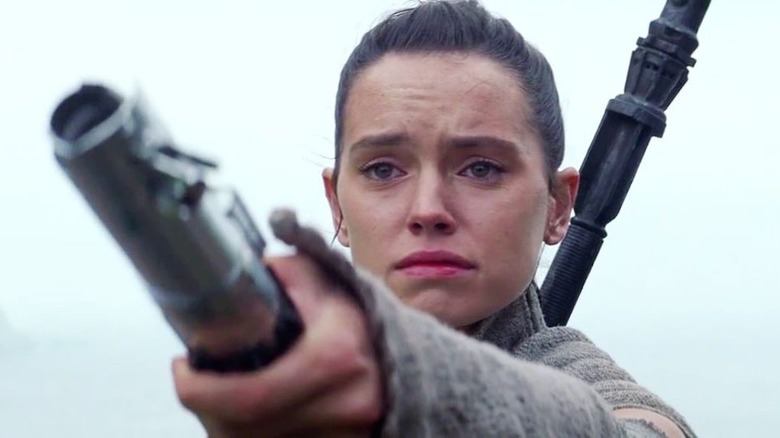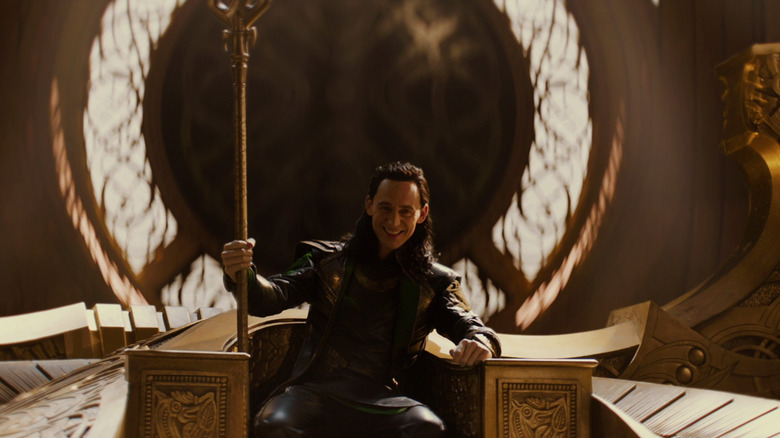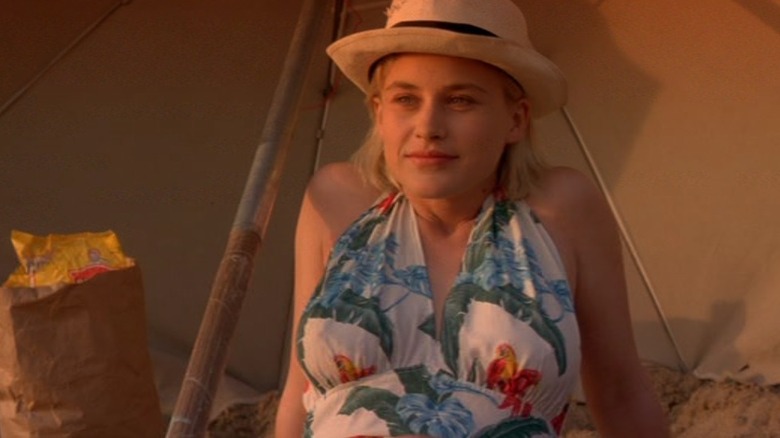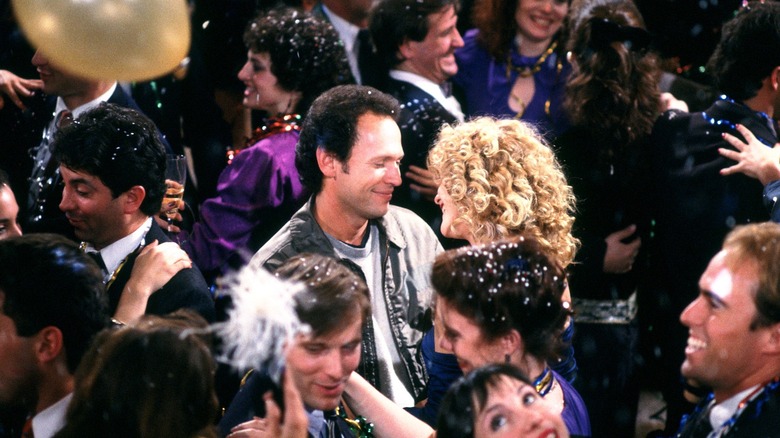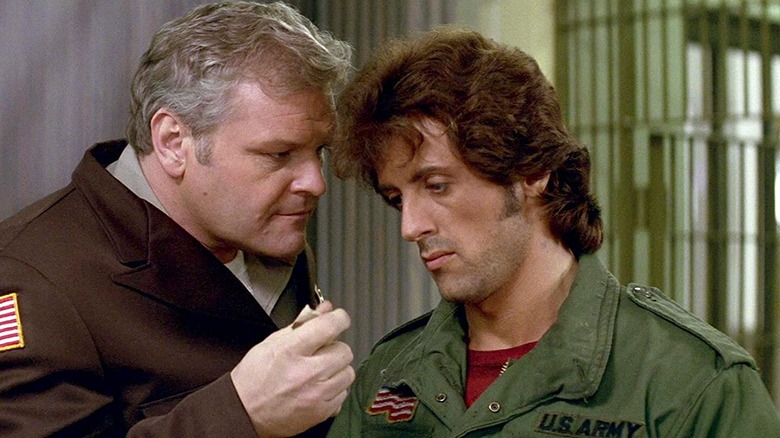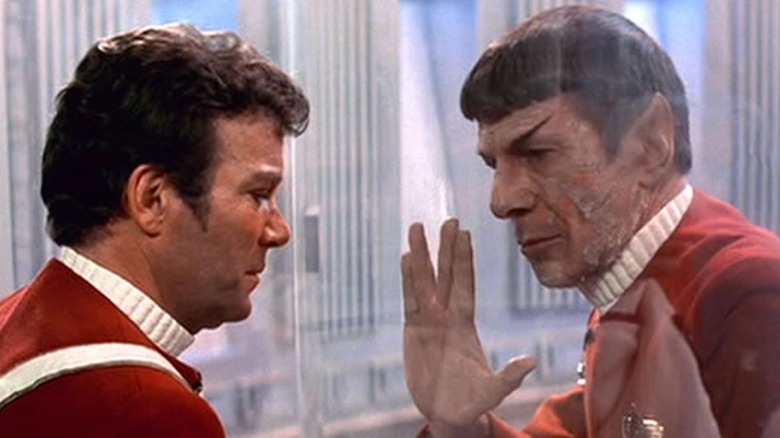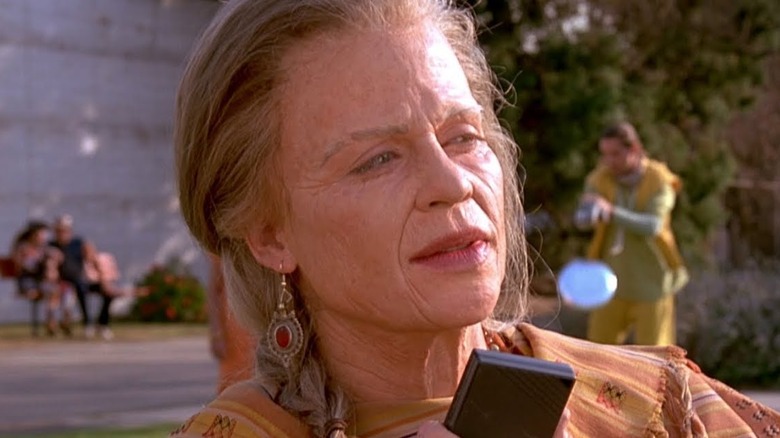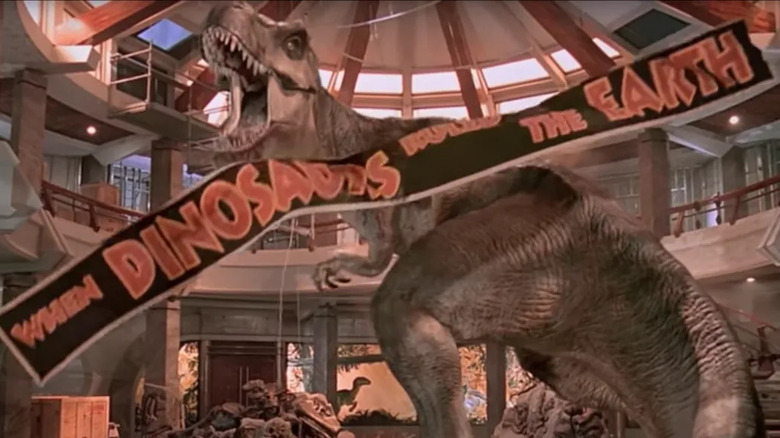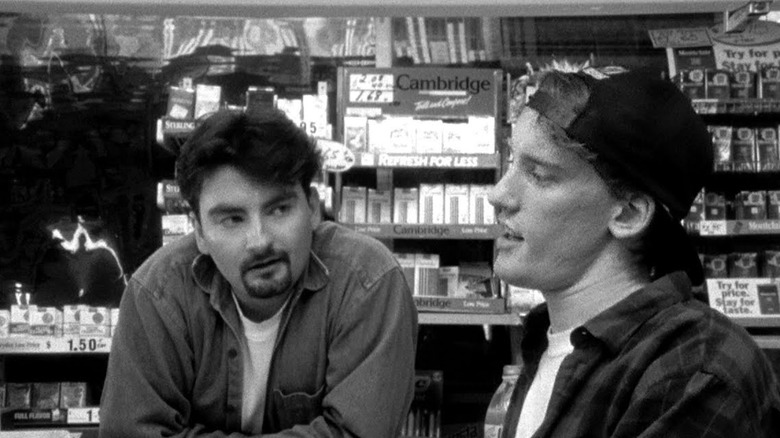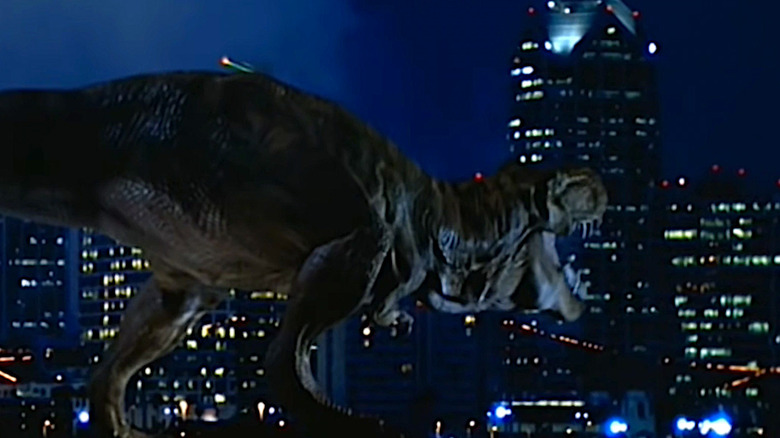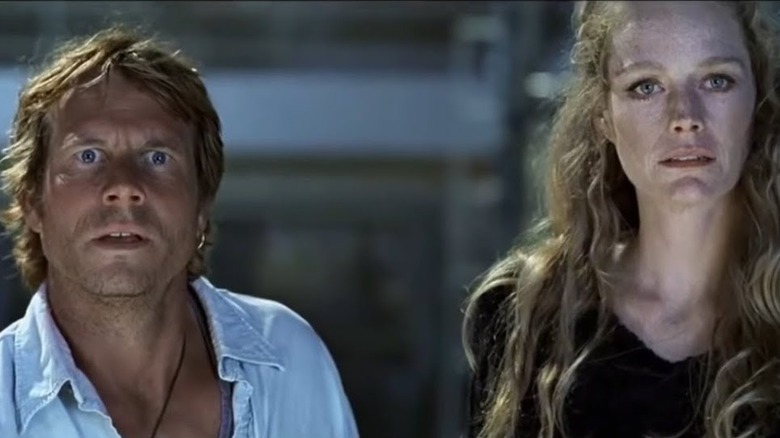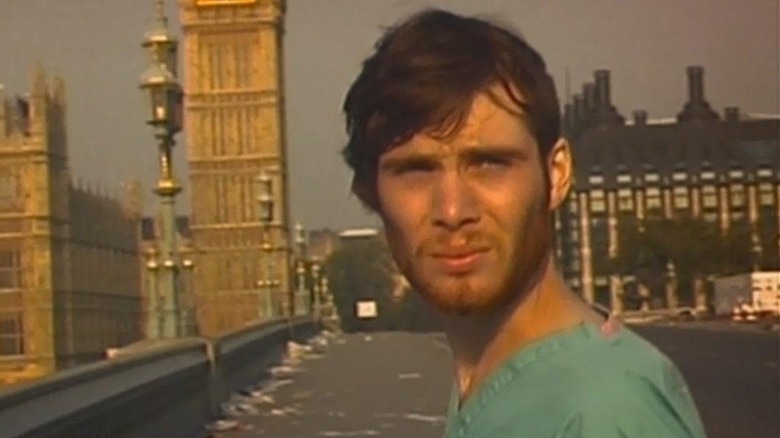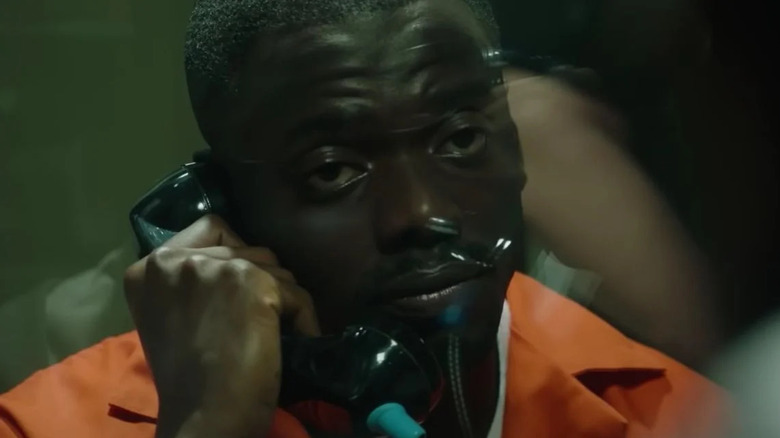Movies With Dramatically Changed Endings
Finding the perfect ending for a movie can be a difficult task. Filmmakers have to end their story on just the right note, or audiences will go home angry — and sometimes, that can involve a lot of trial and error. While some endings come perfectly formed, others evolve over time. In fact, some movies start off with finales that are completely dropped from the film by the time it hits theaters. Perhaps the ending was changed because test audiences absolutely hated it. Maybe an actor refused to shoot a certain scene a particular way, or maybe over the course of shooting, a director realized the story needed an overhaul.
Whatever the reason, the movies on this list had their endings dramatically changed as they worked their way from screenplay to silver screen — some with amazing results and others with less than impressive outcomes. (Be warned. There are a whole lot of spoilers below.)
Army of Darkness was a lot darker
The "Evil Dead" franchise isn't known for its upbeat endings. The first movie finds Ash Williams (Bruce Campbell) dragged off by a demon, and "Evil Dead II" sends our screaming hero back to the Middle Ages. "Army of Darkness," on the other (possessed) hand, ends on a much happier note. After defeating an army of spirits and skeletons, Ash escapes the Dark Ages by drinking a potion and saying some magic words. He winds up back in the modern day, working at a department store, and killing one last Deadite that hitched a ride into the future.
However, this wasn't the ending that director Sam Raimi intended. Originally, Ash was supposed to drink six drops of a magic potion — one for each century — and then he'd fall into a long slumber. When he woke up, he'd be back in the present. However, as he's counting out the drops, Ash gets distracted, loses count, drinks too much, and wakes up in the post-apocalypse. The world has been reduced to rubble, and it's too much for Ash to take. Wide-eyed with terror, he drops to his knees, screaming in agony, and as the film cuts to credits, we hear him laughing like a madman.
Universal Pictures wasn't crazy about this grim ending, so Raimi gave us the epic S-Mart battle instead. Granted, the alternate finale is more in line with the nihilistic tone of the series, but watching Ash go full John Wayne on a Deadite is absolutely awesome, so we're not complaining about studio interference. Hail to Universal, baby.
Die Hard with a Vengeance was incredibly vengeful
"Die Hard with a Vengeance" finds John McClane (Bruce Willis) going toe-to-toe with Simon Gruber (Jeremy Irons), a riddle-loving terrorist with a grudge. After a bunch of bombs and brain-teasers, McClane discovers that Simon is more interested in stealing $140 billion in gold bullion than blowing anything up. So along with his press-ganged sidekick, Zeus Carver (Samuel L. Jackson), McClane tracks Simon down but finds himself in a tricky situation when the bad guy gets both a machine gun and a helicopter.
Thinking on his feet, McClane shoots a powerline, and the falling cables bring down Simon's chopper. Honestly, it lacks the satisfying personal touch that made the showdown in the first "Die Hard" so memorable ... but that's not for lack of trying. In the original ending, Simon escapes to Europe with all the gold, where he's living the easy life when an angry McClane shows up. In this version, McClane has been kicked off the force as the feds suspect him of helping Simon, but now, the ex-cop wants revenge. He puts a Chinese rocket launcher — one missing the directional arrows — on the table between them, and he starts asking Simon riddles. The terrorist doesn't know which way the weapon is aiming, and when he finally gets a riddle wrong, he's forced to pull the trigger.
Unfortunately for Simon, it's aimed straight at his chest, and boom goes the terrorist. It's a pretty epic ending, but according to screenwriter Jonathan Hensleigh, the studio thought it was "too cruel." Admittedly, it's a dark move for McClane, but it's a more satisfying showdown.
Election almost elected for a happy ending
Directed by Alexander Payne, "Election" is a pitch black comedy with a cynical ending. Matthew Broderick plays Jim McAllister, a high school teacher who absolutely hates one of his students: Tracy Flick (Reese Witherspoon), an overeager and narcissistic senior. Of course, McAllister isn't exactly the most mature dude in the room, as he's a grown man trying to sabotage the ambitions of a high school student. So when he's caught rigging the election for student body president against Tracy, he's promptly fired from his post.
In the theatrical ending, McAllister moves to New York, becomes a museum tour guide, and then does a little sightseeing in Washington D.C. That's when he spies Tracy working alongside some prominent politician. Infuriated at her success, he throws a soft drink at her car before hightailing it out. However, there was actually far sweeter ending (discovered on a VHS tape at a flea market, of all places), where McAllister and Tracy actually let bygones be bygones.
In this alternate ending, McAllister never moves to New York. Instead, he's still in his hometown, working as a used car salesman. Tracy shows up, looking for a vehicle, and the two start bonding. McAllister apologizes for his bad behavior and even consoles her when she admits she's worried about going to college. Tracy then asks McAllister to sign her yearbook, and the film ends as the ex-teacher starts writing, "Dear Tracy...." Needless to say, this didn't go over well with test audiences, as the saccharine ending didn't mesh with such a satirical film.
Fatal Attraction was far less fatal
Starring Michael Douglas and Glenn Close, "Fatal Attraction" was a massive hit when it was released in 1987. It was the second highest-grossing film that year, picked up six Oscar nominations, and introduced audiences to Alex Forrest (Close), the seventh-best villain of all time according to the American Film Institute. However, this erotic thriller might not have been so popular if the filmmakers had stuck with the original ending.
If you're not familiar with the plot, "Fatal Attraction" is about a married man named Dan Gallagher (Douglas) who has an affair with the aforementioned Alex Forrest. When he tries to end the relationship, Alex goes a little psycho and attempts to murder Dan's wife. Before she can do the deed, Dan tries to drown her in a bathtub, and then his wife finishes Alex off by filling her full of lead. It's a violent climax to a twisted thriller, and audiences ate it up.
However, the original finale was far kinder to Ms. Forrest. In this alternate ending, Dan is framed for murder, but Alex eventually writes a letter that frees him from blame (while still making it clear that he's an adulterous, womanizing jerk). But test audiences were appalled. They wanted blood, and even though Close and director Adrian Lyne were opposed to changing the ending, Paramount executive Ned Tanen ordered the filmmakers "to terminate the b*** with extreme prejudice."
Happy Death Day wasn't so happy
Released in 2017, "Happy Death Day" tells the story of Tree (Jessica Rothe), a college student caught in a "Groundhog Day"-style time loop. Of course, Tree's predicament is a lot worse than being stuck in a sleepy Pennsylvania town with Ned Ryerson. She's being stalked by a masked killer, and every time she dies, her day starts over ... and she has to face the mysterious murderer yet again.
Eventually, Tree realizes the killer is her sorority sister Lori (Ruby Modine), and after eating a poisoned cupcake, she defeats Lori and breaks the loop. It's a satisfying ending, but the original wasn't quite as hopeful. In this alternate version, Tree is actually murdered in the final few seconds, and the film implies she'll be stuck in the time loop for a long, long time.
Test audiences hated it. As director Christopher Landon explained to CinemaBlend, "[Audiences] were like, 'Wait, she did all this hard work, and made all these changes and she's a better person now. And then you kill her again?'" On top of that, Landon originally intended for there to be two killers: Lori and Gregory Butler (Charles Aitken), the professor Tree was having an affair with. But at the end of the day, he went with just one villain and made sure that Tree would never get caught in a time loop again ... until part two, anyway.
Little Shop of Horrors was far more horrific
When it comes to movies with dramatically changed endings, the most infamous of the bunch belongs to "Little Shop of Horrors." Directed by Frank Oz, this macabre musical finds Rick Moranis playing Seymour, a geeky florist in love with his blonde bombshell of a coworker, Audrey (Ellen Green). In his quest to impress her, Seymour begins raising a venus fly trap he names Audrey II, but as Seymour quickly discovers, this is no normal plant. Not only can this "mean green mother from outer space" talk, it also feeds on human blood ... and it gets bigger with every meal.
A couple of corpses later, Audrey II is gigantic and plans on devouring Seymour and his lady love. And this is where the original and theatrical endings verge in wildly different directions. In the original version, Audrey II takes sadistic glee in devouring our two heroes. Even worse, a whole host of flesh-hungry flowers starts spreading across the world. They grow to kaiju size, chase frightened citizens, and destroy every building in sight.
It's an incredibly impressive sequence with some truly staggering puppet work. According to The Dissolve, the climax cost $5 million of the film's $25 million budget. But when "Little Shop" was screened for test audiences, as Oz put it, "The theater became a refrigerator, an ice box." Audiences went icy cold the moment Audrey II ate Seymour and his hapless girlfriend. So the filmmakers scrapped the plant-pocalypse and let the two heroes live happily ever after ... maybe.
Marathon Man was much more murderous
Based on the novel by William Goldman, "Marathon Man" scared a generation of moviegoers away from the dentist, and to this day, people still shudder when asked, "Is it safe?" After all, the film's main bad guy is Dr. Christian Szell (Laurence Olivier), a dentist who kills and tortures a lot of people to get a case full of diamonds. Unfortunately for Szell, one of his victims is a PhD student and marathon runner named "Babe" Levy (Dustin Hoffman). Babe is just a normal guy caught in an international conspiracy, but after escaping the villain's goons, he comes face to face with the demented doctor for a showdown of gastronomical proportions.
In the final film, Babe forces Szell to swallow his precious diamonds (which the villain stole from Holocaust victims). Eventually, Szell refuses to eat anymore and pulls a knife on our athletic hero. But before he can stab Babe, he tumbles down a flight of stairs and lands on his own knife, dying almost instantly. Novelist/screenwriter William Goldman envisioned a much simpler ending where Babe simply shoots Szell, but Hoffman refused to film the scene that way, saying, "I won't play a Jew who cold-bloodedly kills another human being." Hoffman was so insistent on not shooting Szell that he threatened to walk away from the project; fortunately, a compromise was reached, and instead of filling the dentist full of lead, he filled him full of diamonds instead.
The Predator almost starred Schwarzenegger
Co-written and directed by Shane Black, 2018's "The Predator" ends with our heroes finding a way to defeat the invading extraterrestrials, thanks to some alien tech called the "Predator killer." It's an obvious set-up for a "Predator" part two, but the original script ended with a much cooler stinger for a sequel. In Black and Fred Dekker's screenplay, the movie ends shortly after our ragtag bunch of heroes defeat the Ultimate Predator. Quinn McKenna (Boyd Holbrook), his autistic son Rory (Jacob Tremblay), and biologist Casey Brackett (Olivia Munn) have all survived the battle, but their adventures aren't over quite yet. A helicopter shows up, and who should step out of the "choppa" but Dutch Schaefer himself.
The musclebound mercenary from the original film, Dutch tells the survivors that they need to come with him. That's when little Rory asks, "Me too?" And Dutch responds, "Especially you." That's where the film ends, implying Rory will be essential in the war against the Predators. Unfortunately, Black couldn't get Schwarzenegger for such a small part. As the Governator explained, "They asked me, and I read it, and I didn't like it — whatever they offered. So I'm not going to do that, no. Except if there's a chance that they rewrite it, or make it a more significant role." As a result, we got a pretty decent mech-suit instead.
Pretty in Pink was almost way nicer to Duckie
One of the all-time classic high school movies, "Pretty Pink" was released in 1986, but it's just as beloved today ... and just as controversial. Directed by Howard Deutch and written by John Hughes, this rom-com finds high school senior Andie Walsh (Molly Ringwald) caught between two boys trying to win her heart: preppy Blane (Andrew McCarthy) and quirky Duckie (Jon Cryer). In the theatrical version, the movie ends with Andie and Blane sharing a kiss, leaving millions of Duckie fans howling with anger. But back in '86, it was the exact opposite situation.
In John Hughes' original script, it's Andie and Duckie who end up dancing at the prom. Howard Deutch even screened that ending before a test audience, but moviegoers weren't buying that Andie would end up with her BFF. In fact, they hated it so much that they started booing. So the filmmakers were forced to reshoot the ending, and needless to say, Cryer wasn't happy. "I was disappointed," he told Entertainment Weekly. "You sorta go, 'Oh, guess I'm not the leading man.' But I think it was kind of appropriate. Duckie always thought he was the leading man, and that was his fatal flaw."
Rampage was a monster-sized tearjerker
Inspired by the video game of the same name, "Rampage" finds Dwayne Johnson trapped between some very angry monsters. There's a giant gorilla, a flying wolf, and an oversized crocodile, and they're all hell-bent on destroying as much property as possible. Fortunately, Johnson's character is old friends with the gorilla, a previously friendly primate by the name of George, and he eventually convinces his gorilla pal to battle the other monsters and save humanity.
In the original screenplay, the filmmakers decided to get downbeat and kill off poor George in the final battle. But when Johnson got to that part of the script, he simply wasn't having it. As he explained to Rolling Stone, "I don't like a sad ending. Life brings that s***. I don't want it in my movies. When the credits roll, I want to feel great." Even though the rest of the filmmaking team wanted George to bite the banana, er, bullet, Johnson refused to budge, and when the Rock says the gorilla lives, you better listen.
Scott Pilgrim vs. the World was a whole lot nicer to Knives
Directed by Edgar Wright, "Scott Pilgrim vs. the World" is a video game adventure where Michael Cera trades barbs with Captain Marvel, gets in a bass battle with Superman, and exchanges blows with Captain America, all in his quest to date the girl of his dreams, Ramona Flowers (Mary Elizabeth Winstead). Playing the titular Scott Pilgrim, Cera has to defeat Ramona's seven evil exes if he wants to win her hand. One by one, he beats them into oblivion and finally gets to date the rainbow-haired object of his affection.
Sadly, that means he leaves his old girlfriend, Knives Chau (Ellen Wong), but she seems okay with Scott's choice. However, in the original ending, things took a very different turn after Scott beat Ramona's final boyfriend. In this version, Ramona walks off into the distance, and it's Scott and Knives who get together. Evidently, this was so controversial that people at test screenings actually started arguing about it, so the filmmakers used their 1-up to start over and film a new ending.
A third possible ending would've made fans lose their minds. Wright briefly considered a last-minute twist where we learn everything that had just happened was part of Scott's deranged fantasy and that the slacker was actually a serial killer who'd murdered seven innocent people. Whether you think Scott should've wound up with Knives or Ramona, we can probably all agree it was wise for Wright to skip this crazy ending.
Star Wars: The Force Awakens was a lot more forceful
The ending of "The Force Awakens" is one of the best in the "Star Wars" franchise. After hearing so much about Luke Skywalker, Rey (Daisy Ridley) finally finds the Jedi master on the island of Ahch-To. As the John Williams music starts to swell, Rey offers the bearded knight his long-lost lightsaber, and then we cut to credits. It's a classic ending, re-introducing audiences to a classic hero.
However, "The Last Jedi" quickly (and brilliantly) subverts that ending when Luke grabs the lightsaber and tosses it aside. After making a grave mistake involving Kylo Ren, Luke is trying to cut himself off from the Force, and he's hoping the Jedi Order will die with him. Interestingly, this character arc changed the ending of "The Force Awakens," as J.J. Abrams originally intended to end his film with the Jedi Knight showing off his otherworldly powers.
According to Mark Hamill, "The Force Awakens" was supposed to end with Rey discovering Luke on Ahch-To, and he would be surrounded by floating boulders (no doubt a nod to "The Empire Strikes Back"). However, before "The Force Awakens" hit theaters, Hamill was reading "The Last Jedi" script and realized the former's ending didn't match up with the latter's new direction. So he called up the filmmakers to see what was happening; fortunately, the folks at Lucasfilm had picked up on the problem and altered the ending before the film hit theaters.
Thor: The Dark World was a lot darker for Loki
Loki's death in "Avengers: Infinity War" sparked a lot of controversy among Marvel fans, but this wasn't the first time the god of mischief had met his fate. In the original cut of "Thor: The Dark World," Loki is actually killed in his battle with Algrim, the monstrous elf with a bad attitude. So when Thor and Loki say their heartbreaking goodbyes (the one so beautifully parodied in "Thor: Ragnarok"), that was supposed to be for real. However, Loki fans weren't going to stand idly by and let the MCU get away with murder. As Tom Hiddleston explained on the Empire Film Podcast (via The Indian Express), "In test screenings, the audience didn't accept it. There was a very strange and almost unanimous resistance to it."
So Marvel was forced to change the ending of the film, revealing that Loki was alive and well and looking a lot like Anthony Hopkins. While it might've felt like a copout at the time, it wonderfully set up everything that happened in "Ragnarok," so this is one time where test audiences did a marvel-ous job.
True Romance wasn't as romantic
Directed by Tony Scott, "True Romance" is based on a script by Quentin Tarantino, so it's filled with the requisite amount of f-bombs, pop culture references, and gratuitous violence. However, the one thing it's missing is Tarantino's original ending. In his version, Clarence (Christian Slater) and Alabama (Patricia Arquette) don't live happily ever after; instead, things take a dark turn at their ill-fated drug sale.
With mobsters and cops firing in all directions, Clarence is killed in the gunfight, and when Alabama escapes, she's heading off to Mexico all by her lonesome. But while he was making the movie, Scott had a change of heart. He grew incredibly fond of the two lovers and wanted to give them a happy ending, and since the film was being shot in sequential order, he was able to rewrite the script and let the duo start a new life. It might not have been the ending Tarantino intended, but after everything Clarence and Alabama go through, it's the definitely the ending this couple deserved.
When Harry Met Sally... was almost the saddest rom-com ever made
One of the all-time great rom-coms, "When Harry Met Sally..." finds Billy Crystal and Meg Ryan caught in a will they-won't they friendship that spans years. After a lot of setbacks and heartbreak, the couple finally get together on New Year's Eve — the perfect ending to a brilliant comedy. However, things were originally going to be a lot more melancholy. In Nora Ephron's screenplay, the two lose touch for a few years, and at the end, they reunite for a few brief moments, catching up one last time before parting ways again.
That all changed when director Rob Reiner found love. See, Reiner was dealing with some heavy personal issues while making "When Harry Met Sally..." As he explained to PeopleTV (via Entertainment Weekly), "I was single for ten years and making a mess of my personal life, in and out of relationships and not being able to make anything work." However, Reiner met the woman who would become his wife, Michele Singer, while shooting the film, and that radically changed his outlook on everything... including the ending of his rom-com. Caught in the swells of romance, Reiner changed the finale during filming, allowing Harry and Sally to wind up together. Hopefully those fictional characters had as much luck in their relationship as Mr. and Mrs. Reiner, as the two are still married to this day.
First Blood nearly ended John Rambo's cinematic adventures early
While the name Rambo has virtually become synonymous with action movie heroes from the 1980s, Sylvester Stallone's one-man army nearly was brought to a definitive end in his debut film.
1982's "First Blood” followed the Vietnam War veteran as he was targeted by an overbearing small town sheriff, leading to an escalating conflict that saw Rambo outmaneuver the National Guard and elude authorities. This showdown culminated with Rambo using a machine gun to shoot up buildings throughout town before he was confronted by his old commanding officer, Colonel Trautman.
The original ending mirrored the original novel by David Morrell, in which Trautman shoots Rambo dead — though in the film, it's Rambo that manually forces his old friend to pull the trigger, effectively killing himself. Though this ending was filmed and included as a deleted scene on the home video release, director Ted Kotcheff told Entertainment Weekly that both he and Stallone felt the original conclusion was too grim. They then created the film's theatrical ending, with Rambo surrendering to Trautman. Given that Rambo went on to become one of Stallone's longest-running film franchises, the filmmakers made the right decision.
Star Trek II: The Wrath of Khan almost closed the door on Spock's return
One of the most heartbreaking scenes in "Star Trek" history is the death of fan-favorite character Spock at the end of 1982's "Star Trek II: The Wrath of Khan." In the film's climax, Spock heroically sacrifices his life to repair the Enterprise's warp drive, allowing it to escape the Genesis weapon as he is dosed with lethal radiation. However, the movie ends with strong hints that audiences have not seen the last of Spock, with his coffin seen on the newly formed Genesis planet while the character narrates the famous "Star Trek" intro monologue.
Originally, "Star Trek II" lacked this more hopeful conclusion, with Spock's death being more definitive. Executive producer and co-writer Harve Bennett devised the expanded, more uplifting ending. Post-production included reshoots on the Genesis planet, with Nimoy recording the monologue. Director Nicholas Meyer objected to these changes for undoing Spock's death too obviously to the audience, but did not stop their inclusion.
Terminator 2: Judgment Day originally gave the Connors a happy ending
"Terminator 2: Judgment Day" is one of those rare sequels that outdoes its predecessor, as filmmaker James Cameron reunited with his main cast to make the ultimate sci-fi action movie. As a teenage John Connor finds himself hunted by an even more advanced killing machine from the future, his mother Sarah reluctantly teams up with a repurposed T-800 to protect him and humanity's eventual salvation. And rather than leave room for seemingly endless sequels to exploit, "Terminator 2" originally concluded with a definitive happy ending for the Connor family.
In the film, Sarah experiences a nightmare, where she witnesses a playground full of children get violently incinerated by a nuclear blast. This scene set up the film's originally intended ending, with an older Sarah serenely watching an adult John play with his daughter at a similar playground. Producer Stephanie Austin told Den of Geek that, after an early cut of the film with this ending was screened for the crew, the filmmakers felt this conclusion didn't resonate as well as they hoped. Seeking to create something more evocative, the altered ending with the open road was used for the final cut of the movie instead.
Jurassic Park let its humans save themselves
One of the biggest movies of all time is "Jurassic Park," which opened to rave reviews and earned well over $900 million at the worldwide box office during its initial theatrical run in 1993. Based on the bestselling Michael Crichton novel of the same name, "Jurassic Park" has a theme park populated by cloned dinosaurs descend into chaos after it gets overrun by its own prehistoric attractions. As paleontologists Alan Grant and Ellie Sattler lead two children to safety, they are rescued in the nick of time by a T-Rex who attacks the velociraptors that are menacing them.
However, instead of the humans conveniently saved by a Tyrannosaurus Rex seemingly appearing out of nowhere, they were forced to fend for themselves in the movie's original ending. Storyboards from the scrapped ending had the survivors maneuver the raptors into dinosaur skeletons displayed in the visitor center and kill them with the sharp, heavy bones. In "Return to Jurassic Park: Making Prehistory," the filmmakers revealed that they decided to give the T-Rex the coup de grace after being impressed by how powerful the creature's depiction became during production.
Clerks pivots from a workplace comedy to a bloody crime story
1994's "Clerks" is the movie that launched filmmaker Kevin Smith's career, with the auteur writing, directing, producing, and appearing in the movie as Silent Bob. The low-budget comedy revolved around a day in the life of its protagonist Dante Hicks, working as a convenience store clerk in New Jersey. And while "Clerks" kicked off an entire shared cinematic universe filled with ribald commentary on daily life and pop culture, the original ending nearly ended Dante's shift permanently.
In the theatrical ending, Dante closes up shop after a hard day at work and crashing local funerals, with his best friend Randal teasing him as he departs. A filmed but thankfully unused ending went one step further, with someone gunning down Dante in cold blood and steal from the cash register. Smith decided to omit the original ending after receiving negative feedback about it from early screenings, admitting (per Rolling Stone) he didn't quite know how to end the film.
The Lost World: Jurassic Park almost kept its dinos out of San Diego
Steven Spielberg returned to the blockbuster success of the original "Jurassic Park" as the director of its 1997 sequel "The Lost World: Jurassic Park." Going bigger and more bombastic with its action than its predecessor, the movie has the nefarious InGen Corporation decide to take dinosaurs from Isla Sorna to a planned theme park in California. Though the survivors of this expedition narrowly escape Isla Sorna with their lives, they must contend with a T-Rex rampaging through the streets of San Diego upon their return.
Starlog Magazine notes that the San Diego finale to "The Lost World" was suggested by Spielberg five weeks before the start of principal photography, which necessitated a rewrite from the original ending. The film's original conclusion saw the survivors escape the island only to face a pterodactyl in a high-flying fight. Spielberg told Time that he envisioned dinosaurs invading the mainland for an eventual third "Jurassic Park" film but, realizing he was likely not to helm such a project, decided to have the fun in directing such a sequence with the changed ending.
Titanic gave its plot-driving treasure one last hurrah
James Cameron's other blockbuster '90s film, "Titanic," was a major change of pace for the director, eschewing his penchant for action in favor of a tragic period piece romance. After a treasure hunter named Brock Lovett explores the wreckage of the HMS Titanic, one of the ship's few surviving passengers, Rose Calvert, recounts to him a whirlwind love she had before the ship sunk. After recalling her experience on the ill-fated ocean liner, Rose drops the priceless diamond Brock was searching for in the ocean, with Brock unaware that she had it the whole time.
Cameron had originally written and filmed an ending scene where Brock and Rose's granddaughter Lizzy witnessed her disposing of the diamond as a way to resolve the fortune seeker's character arc. In the alternate ending, Rose allows Brock to hold the diamond before tossing it in the ocean, as he admits the treasure doesn't matter in the grand scheme of life. Cameron felt the audience wouldn't be invested in Brock's character arc following the extended flashback. Actor Bill Paxton agreed, telling Yahoo that the scene didn't work with his character included.
28 Days Later toyed with killing its main hero
Director Danny Boyle and screenwriter Alex Garland's zombie thriller "28 Days Later" sees humans infected by pure rampage overrunning Great Britain within a month. Following the widespread societal collapse, a young man named Jim awakens alone in a deserted London hospital, shocked at what has happened to the world since he became comatose. In the theatrical ending, Jim and his fellow survivors are able to flag a passing Finnish aircraft, suggesting that they may have lived long enough to escape their post-apocalyptic hellscape.
However, Jim was not always intended to survive the events of the film, with several different planned endings featuring the protagonist's untimely demise. One filmed ending saw Jim succumb to gunshot wounds he endured in the climax, with his friends Selena and Hannah leaving him behind. Another ending, which did not progress beyond the animatic stage, saw Jim sacrifice himself by offering a complete blood transfusion to Hannah's infected father in order to cleanse him of the contagion.
Rogue One considered sparing its doomed rebels
"Rogue One: A Star Wars Story" explored the events that set the original "Star Wars" trilogy in motion. An outgunned Rebel Alliance makes a daring raid on a remote Imperial planet Scarif, obtaining the plans to the Galactic Empire's secret weapon: the Death Star. Though successful in transmitting the data to the rest of the Alliance, the intrepid squad is wiped out when the Death Star fires on their location on Scarif.
While the creative team always envisioned protagonists Jyn Erso and Cassian Andor heroically sacrificing themselves for the Alliance's greater victory, another ending was planned. Screenwriter Gary Whitta revealed to Entertainment Weekly that an ending sparing Jyn and Cassian was written in case Disney thought killing off both of the film's lead characters would be considered too dark. Fortunately, Lucasfilm President Kathleen Kennedy decided to stick with the original plan, agreeing with the decision to leave the entire squad to their pyrrhic victory on Scarif.
Get Out placed its hero firmly behind bars
The 2017 film "Get Out" marked filmmaker Jordan Peele's shift from television comedy to cinematic horror, with Academy Award-winning success. A young man named Chris Washington visits his girlfriend Rose Armitage's parents for the first time, in a remote Upstate New York town, only to discover this community has a twisted secret. Rose's family and their neighbors take control of Black people's bodies in a bid for immortality, submerging the original consciousness to facilitate this subjugation.
In the theatrical ending, Chris kills the Armitage family and successfully escapes as he is picked up by his friend in the TSA. In one of the filmed endings, Chris is discovered by the police instead, who arrest him on the spot for murdering Rose in apparent cold blood. According to an oral history in Vulture, Peele observed that test audiences reacted poorly given sociopolitical changes and decided to give "Get Out" a happier ending instead.
